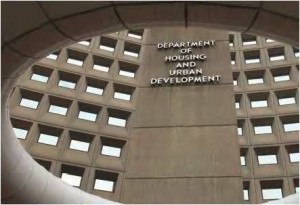In September 1965, President Lyndon Johnson signed into law legislation establishing the U.S. Department of Housing and Urban Development (HUD) as the eleventh department of the federal government. At the time President Johnson said, “We must make sure that every family in America lives in a home of dignity and a neighborhood of pride, a community of opportunity and a city of promise and hope.” Good housing and strong communities are not only a source of hope, but a driving force of our economy, so for the last 50 years, HUD’s mission has focused on issues of affordable housing, responsible homeownership, tackling homelessness, and contributing to economic development. In order for HUD to achieve its program goals, its operations must be efficient, effective, and serve customer needs. Nani Coloretti, Deputy Secretary, U.S. Department of Housing and Urban Development joined me on The Business of Government Hour to discuss the key strategic priorities for HUD, how HUD is positioning itself as the Department of Opportunity, and what the department is doing to improve its operational performance. The following is an edited excerpt of our discussion, complemented with additional research. – Michael J. Keegan
On the History and Mission of HUD. The department’s mission is to create strong, sustainable, inclusive communities and quality, affordable homes for all. As you noted, it was established in September 1965 in the midst of unrest occurring in cities throughout the nation. The Housing and Urban Development Act of 1965 granted HUD new authorities and consolidated the work of several government agencies, including the Federal Housing Administration and now-defunct entities such as the Public Housing Administration.
Beginning in 1968, our department began enforcement of the Fair Housing Act, which prohibits housing discrimination based on factors such as race, religion, gender, disability, and family status. Since 1974, our Community Development Block Grant (CDBG) Program, what we call t CDBG, a has awarded more than $144 billion to state and local governments for the rehabilitation of affordable housing, the construction of public facilities, and the creation of job growth and business opportunities. Since the passage of the Stewart B. McKinney Act in 1987, HUD has given over $14 billion to thousands of local partners that combat homelessness. In the last 20 years alone, HUD has provided public housing and rental assistance to more than 35 million people, including support for the elderly and disabled.
During the last 10 years, in the aftermath of Hurricane Katrina, we’ve begun to play a larger role in helping communities recover from natural disasters and build more resilient infrastructure. And under Secretary Shaun Donovan, HUD played a huge role in supporting the housing market during the Great Recession, and providing access to credit when others were unwilling.
 On Managing the Operations of HUD. As the HUD Deputy Secretary, I help the department achieve its mission by focusing on effective operations and cross-cutting policy and program issues. For example, I am working to build a stronger HUD, which means structuring the agency to address its most pressing needs in a time of declining administrative resources. The entire agency reports up to the secretary through me. Let me give you a sense of the scale and operation of the department.
On Managing the Operations of HUD. As the HUD Deputy Secretary, I help the department achieve its mission by focusing on effective operations and cross-cutting policy and program issues. For example, I am working to build a stronger HUD, which means structuring the agency to address its most pressing needs in a time of declining administrative resources. The entire agency reports up to the secretary through me. Let me give you a sense of the scale and operation of the department.
HUD is organized into several broad program areas to provide housing and to use housing as a platform for opportunity. Our main program areas are:
- The Federal Housing Administration, which has insured 40 million loans since its inception and which also ensures access to credit
- Public and Indian Housing, which funds public housing and also housing choice vouchers that allow people to live in different parts of the community
- Community Planning and Development, which provides funding to communities for a variety of community-driven solutions to improve housing, homelessness and to expand economic opportunities for low and moderate income persons.
- The Fair Housing and Equal Opportunity program works to eliminate housing discrimination, promote economic opportunity, and achieve diverse, inclusive communities by leading the nation in the enforcement, administration, development, and public understanding of federal fair housing policies and laws.
HUD’s budget is approximately $46 billion. Over 85% of our total budget is needed to renew rental assistance to 5.5 million Americans who live in federally subsidized housing. We have about 8,000 employees spread across 10 regional and 54 field offices located in all 50 states, Puert o Rico, and the District of Columbia.
o Rico, and the District of Columbia.
On Challenges. The top two challenges are sustaining great work and results while working under a constrained budget that will not be getting better in the near future. This means that everyone will continue to be asked to do more with less.
Another challenge at HUD is the persistent low morale, as measured by the Federal Employee Viewpoint Survey (the EVS). To address all of these, I worked with staff to conduct a review of the agency with its employees – something we called “the Deep Dive,” which I can talk about later in the hour. From the Deep Dive, the top three areas I’m focusing on now are:
- Promoting leadership and increasing collaboration
- Increasing accountability and customer service
- Improving resource management
For each of these areas, we have put together a set of projects, or, workstreams that together with staff, I believe can help improve HUD’s current challenges: For example, in improving leadership and engagement we are focusing on focus on SES and manager leadership, engagement and accountability as well as succession planning. In order to improve customer service, we are looking at a customer relations management project that will help HUD become more responsive. Finally to improve resource management, we established quarterly management reviews that will help us track operational goals and resources towards those goals.
At the same time, the Secretary Castro and I worked on improving the response rate for this year’s EVS, and we set a goal to increase our participation from 51% to 75%. This would be a large increase, and hard to achieve. But through many meetings I conducted with every region, I explained the importance of this: we can’t work to improve morale unless we are certain we are solving the right problem. With such a low participation rate, it was difficult to attribute the results as representative, and it also concerned me that only half the employees at HUD responded to this survey.
Two things happened:
- HUD rose to the challenge and our response rate was 73.5% – the largest increase of any cabinet agency.
- The other thing that happened was that the scores went up on almost all of the questions–69 out of 71 questions.
Normally, a 2 percentage point increase is a major shift – but at HUD our average EVS score increased nearly 5 percentage points. The questions that contribute to overall employee satisfaction increased the most, at 7.4% percentage points.
There is definitely more work to be done, but these results were encouraging . HUD does actually either meet or exceed the federal average on many of the questions, but on many of them, we’re still way below even though we went up.
On the “Department of Opportunity” Agenda. Just to provide context, Secretary Castro refers to HUD as “The Department of Opportunity” because of the unique impact it can make on people’s lives. When Secretary Castro arrived at HUD he distilled his opportunity agenda into six goals which I’ll outline. I will also tell you about our agency priority goals. They are the goals tracked on performance.gov, giving you a sense of what we are looking at and monitoring quarterly.
Here are the six main goals to reach our vision:
- Helping families and individuals secure quality housing by promoting responsible homeownership and expanding our affordable rental markets.
- Leading the fight to end veterans and chronic homelessness.
- Leveling the playing field for Americans from all walks of life by fighting housing discrimination.
- Strengthening rural, tribal, and urban communities through our place-based initiatives.
- Addressing climate change by preparing communities for extreme weather and other disasters, and strengthening their economic and environmental resilience.
- Building a stronger HUD by improving leadership, accountability and transparency, and by focusing on better resource management.
That sixth goal is my favorite goal because if we build a stronger HUD by improving leadership, accountability, transparency, and focusing on better resource management, then we’ll be better prepared to successfully achieve the other five goals.
Our agency priority goals help realize some of this, and we track these at least quarterly. Our current goals are:
- Preserve and expand affordable rental housing through HUD rental housing programs.
- End veterans homelessness
- Increase the energy efficiency and health of the nation’s housing stock.
On Tackling the Affordable Housing Crisis. In urban markets in particular you just have sky rocketing rent. It’s an economic problem. There is not enough supply and too much demand. Our nation is in the midst of an affordable housing crisis: HUD estimates that almost 8 million low-income families spend more than half their income on rent, live in substandard rental housing, or both. That’s why we’re taking steps to support and expand our affordable rental market.
We’re working with the OMB, the Treasury, and Federal Housing Finance Agency to stand-up the National Housing Trust Fund, which will generate hundreds of millions of dollars towards creating and developing rental housing for low-income families. We recently published an interim rule about the Fund earlier this year, and hope that grantees will begin receiving allocations as soon as the summer of 2016.
To streamline, we are working on an updated draft of FHA’s Multifamily Accelerated Processing Guide – also known as the MAP guide – which serves as the operating handbook for multifamily underwriting. It compiles HUD’s recent policy changes into a single source and proposes new improvements for public discussion. The completed guide will provide lenders with the clarity they need to get credit flowing into the market.
We’re also streamlining the way we do business through our “Multifamily for Tomorrow” project, which will reduce waiting times for approving FHA-applications and allow developers to build at a faster pace.
Finally, we have asked for additional funding for the HOME Investment Partnerships Program (HOME), which provides formula grants to States and localities that communities use – often in partnership with local nonprofit groups – to fund a wide range of activities including building, buying, and/or rehabilitating affordable housing for rent or homeownership or providing direct rental assistance to low-income people.
HOME is the largest Federal block grant to state and local governments designed exclusively to create affordable housing for low-income households. HOME funds have helped build affordable housing units in big cities, small towns, and rural communities alike. HOME funds provide financing for a variety of housing related projects, including critical affordable rental and homeownership housing, and housing for the homeless.
There are buildings are DC that have used that funding stream and faired successfully. For FY16, the fiscal year that starts October 1, we had a proposal and the senate bill cut that by 93%. They really took a hammer to it. The 93% reduction to HOME funds would leave most jurisdictions with no funds to build any significant amount of housing units, and would hamper our ability to end homelessness and provide housing supports. It’s such a big cut that certain communities won’t be able to use the grant because you need a certain amount of money just to get a unit or a building financed. That is one area we’re keeping an eye on in hopes that some of that money will come back and come back for localities.
On Housing as a Platform to Improve Outcomes. There are specific ways to use housing as a platform to improve outcomes. HUD’s Office of Healthy Homes announced that it will provide nearly $102 million to 32 local and state agencies. This funding will help our partners on the ground eliminate lead-based paint and other household hazards such as mold and carbon dioxide for over 6,000 households. Our work will help parents and students spend more time at the office and in the classroom, and less time in a doctor’s waiting room. We also know that stable housing, made possible with HUD support, provides an ideal platform for delivering a wide variety of health and social services to improve health, education, and economic outcomes. Through partnerships at the federal, state, and local levels, HUD uses its housing platform to deliver a wide variety of services to improve the quality of life of its residents and the surrounding community. We are working to find ways to connect residents of HUD-supported housing to affordable health insurance. We are working with our partners at the Center for Medicare and Medicaid Services (CMS) at HHS to better align housing with the health care services that can be paid for by Medicaid. Comprehensive health services are an important component permanent supportive housing – the game-changing intervention that has been proven to work for people experiencing chronic homelessness.
On Efforts to End Homelessness. Five years ago President Obama introduced Opening Doors, a comprehensive strategy for ending veteran homelessness that involves 19 federal agencies – including HUD, the VA, and the Department of Labor. We’re making tremendous strides thus far. Earlier this year New Orleans became the first major city in the U.S. to meet the Mayors Challenge to end veteran homelessness. And this past June, Houston announced that it can now provide every homeless veteran within its community with access to permanent housing and crucial support services. HUD and its partners are using proven strategies to tackle this challenge. These solutions include obtaining accurate data on individuals facing homelessness within a particular community, creating a single system that ensures everyone receives consistent access and information on available services, providing permanent supportive housing to the chronically homeless, and connecting people to job training and employment opportunities. This can happen because we are using data to drive results. We track how well we’re doing towards these goals in what we call HUDStat, which is a quarterly review of our performance progress, we invite our strategic partners such as the Department of Veterans Affairs to delve into the numbers and assess how are we doing to meet our goals and really explore what is happening beneath the numbers. We’re using data to guide our policy decisions.
The key to building upon this work is fostering collaboration between local government, community leaders, and federal partners. This includes improving coordination and communications between every stakeholder, and asking folks to emphasize the importance of securing permanent housing. That’s the best way we can meet the administration’s goal to prevent and end homelessness among children, families, and youth by the year 2020.
On the Future. We’re now preparing HUD for our next 50 years. Since Secretary Castro assumed his position last summer, we’ve accomplished a lot, including supporting responsible and affordable homeownership by lowering FHA’s Mortgage Insurance Premiums; combating housing segregation through the Affirmatively Furthering Fair Housing rule; and expanding opportunity for future generations through innovative initiatives like ConnectHome, which aims to accelerate broadband adoption by children and families living in HUD-assisted public housing in 28 communities across the nation.
You can listen to my complete conversation with Deputy Secretary Coloretti on The Business of Government Hour or all my interviews with government executives changing the way government does business at the businessofgovernment.org.





Leave a Reply
You must be logged in to post a comment.